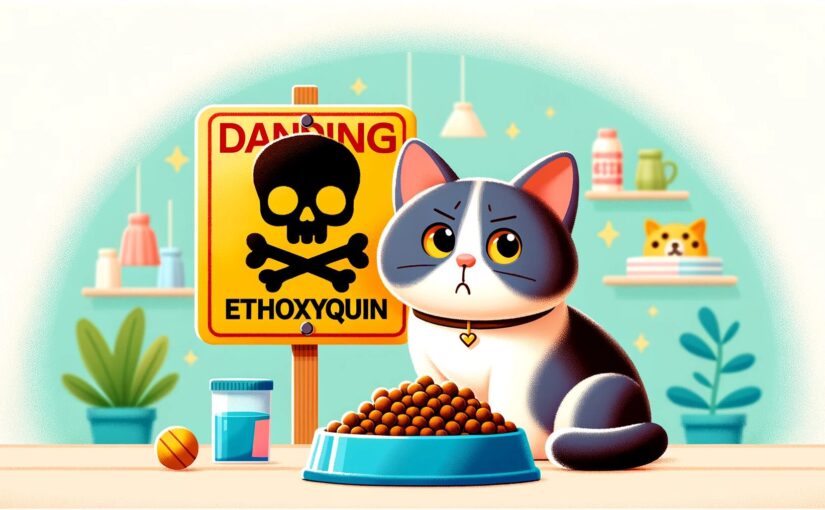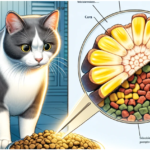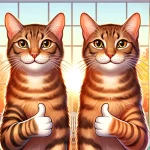As a loving cat owner, you want to do the very best for your furry family members. And providing them with high-quality, nutritious food is an important part of what we do for them. Unfortunately, many commercial cat foods contain additives and preservatives that can be harmful. Ethoxyquin, a questionable chemical preservative, is often found in many popular pet foods. In this article, we will look at what it is, why Ethoxyquin in cat food is concerning, the different names it may appear under on labels, and the potential health issues it can cause.
What is Ethoxyquin?
Ethoxyquin is a synthetic antioxidant that has been used for decades in the pet food industry. Initially developed as a pesticide and a rubber stabilizer, Ethoxyquin was later adopted by pet food manufacturers to preserve fats and prevent them from becoming rancid. This preservative is highly effective in extending the shelf life of pet food, ensuring that it remains fresh and palatable for longer periods.
Why is Ethoxyquin in Cat Food?
The primary reason for the use of Ethoxyquin in cat food is its ability to prevent oxidation. When fats oxidize, they can become rancid, leading to the degradation of the food’s nutritional value and potentially causing gastrointestinal issues for cats. By adding Ethoxyquin, manufacturers can maintain the quality and stability of the fats and oils in cat food, thereby prolonging its shelf life.
Other Names for Ethoxyquin on Cat Food Labels
Ethoxyquin can be listed under various names on cat food labels, which can make it challenging for pet owners to identify its presence. Some of the alternative names and related compounds include:
- E324: This is the European food additive code for Ethoxyquin.
- Ethoxyquinoline
- Ethox
- Santoquin
- 6-Ethoxy-1,2-dihydro-2,2,4-trimethylquinoline
Being aware of these alternative names can help you make informed choices when selecting cat food for your pet.
Potential Health Issues Caused by Ethoxyquin
While it is effective in preserving pet food, the safety of Ethoxyquin in cat food has been a topic of debate among pet owners and veterinarians. Several potential health risks have been associated with Ethoxyquin consumption in cats:
1. Liver and Kidney Damage
Studies have suggested that prolonged exposure to Ethoxyquin may lead to liver and kidney damage in cats. These vital organs are responsible for filtering toxins from the body, and any impairment can have serious consequences for your cat’s health.
2. Cancer
There is growing concern that Ethoxyquin may be a carcinogen. While definitive evidence is still lacking, some research has indicated a potential link between Ethoxyquin and an increased risk of cancer in pets. This risk is particularly concerning given the long-term nature of pet food consumption.
3. Allergic Reactions
Some cats may develop allergic reactions to Ethoxyquin, manifesting as skin irritations, itching, and gastrointestinal upset. These reactions can cause significant discomfort and may require medical intervention.
4. Reproductive Issues
There is some evidence to suggest that Ethoxyquin may negatively impact reproductive health in cats. This includes potential effects on fertility and developmental issues in offspring.
Alternatives to Ethoxyquin
Given the potential risks associated with Ethoxyquin, many pet owners are seeking alternatives. Several natural preservatives can be used in place of Ethoxyquin, including:
- Vitamin E (Tocopherols): A natural antioxidant that can help preserve fats without the associated risks of synthetic chemicals.
- Vitamin C (Ascorbic Acid): Another natural antioxidant that can aid in preserving pet food.
- Rosemary Extract: Known for its antioxidant properties, rosemary extract can help maintain the freshness of pet food.
Conclusion
As a conscientious cat owner, it is so important to be aware of the ingredients in your pet’s food. Ethoxyquin, while effective as a preservative, poses several potential health risks that cannot be ignored. By understanding what Ethoxyquin is, why it is used, and the dangers it presents, you can make more informed decisions about your cat’s diet. Always read labels carefully and consider opting for cat food brands that use natural preservatives. Your cat’s health and well-being depend on the choices you make.
References
- FDA, Labeling and Use of Ethoxyquin in Animal Feed
- ToxinFreeUSA.org, Is There Something Fishy About Your Pet Food







Your blog is a testament to your dedication to your craft. Your commitment to excellence is evident in every aspect of your writing. Thank you for being such a positive influence in the online community.